Further, the seesaw theory of abrupt climate change is far more plausible than the ludicrous, stretched-thin theory that global warming is causing record-high levels of Antarctic sea ice and more record-high levels of snow and cold. In fact, climate models robustly predicted the opposite of what has caused the recent record-cold US weather.
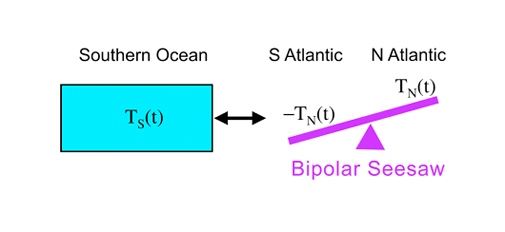 |
Schematic of the bipolar seesaw. North Atlantic temperature changes are mirrored by equal amplitude South Atlantic changes of opposite sign. Southern Ocean temperatures are relaxed toward this South Atlantic temperature. Source: Modeling the Bipolar Seesaw.
|
The seesaw theory of climate is also entirely consistent with conservation of energy, unlike Trenberth's theory of "missing heat" from man-made CO2 "hidden" somewhere within in the climate system.
Seesaw theory in action:
Arctic/Antarctic Mirror Graph Day 260
For those who say Antarctic Sea Ice Extent increases are small and have nothing in common with Arctic losses:
Repost:
Sunday, March 30, 2014
New paper supports the bipolar seesaw theory of abrupt climate change
A paper published today in Nature finds "clear" evidence of a "hydrologic seesaw in which latitudinal migrations of the Intertropical Convergence Zone (ITCZ) produce simultaneous wetting (increased precipitation) in one hemisphere and drying in the other." According to the authors, these shifts can have "serious effects on temperate climate systems. Furthermore, our result implies that insolation-driven ITCZ dynamics may provoke water vapour and vegetation feedbacks in northern mid-latitude regions and could have regulated global climate conditions throughout the late Quaternary ice age cycles."
The paper provides additional, "clear" evidence supporting the "bipolar seesaw theory of abrupt climate change." "Theoretical models and observational data have long suggested that the Northern and Southern Hemisphere climates behave in a seesaw-like fashion: when the northern ocean warms, the southern ocean cools and vice versa."
Mid-latitude interhemispheric hydrologic seesaw over the past 550,000 years
The paper provides additional, "clear" evidence supporting the "bipolar seesaw theory of abrupt climate change." "Theoretical models and observational data have long suggested that the Northern and Southern Hemisphere climates behave in a seesaw-like fashion: when the northern ocean warms, the southern ocean cools and vice versa."
Given that ice cores show a lag between Arctic and Antarctic climate changes of 300-1500 years, it begs the question given that Antarctic sea ice is at record highs and Arctic sea ice has declined during the satellite era, whether this may represent part of a natural seesaw pattern, shifting heat via the thermohaline circulation from the Southern Hemisphere to the Northern Hemisphere and explaining why less warming has been observed in the Southern Hemisphere since 1850.
Mid-latitude interhemispheric hydrologic seesaw over the past 550,000 years
Nature advance online publication 30 March 2014. doi:10.1038/nature13076
Authors: Kyoung-nam Jo, Kyung Sik Woo, Sangheon Yi, Dong Yoon Yang, Hyoun Soo Lim, Yongjin Wang, Hai Cheng & R. Lawrence Edwards
An interhemispheric hydrologic seesaw—in which latitudinal migrations of the Intertropical Convergence Zone (ITCZ) produce simultaneous wetting (increased precipitation) in one hemisphere and drying in the other—has been discovered in some tropical and subtropical regions. For instance, Chinese and Brazilian subtropical speleothem (cave formations such as stalactites and stalagmites) records show opposite trends in time series of oxygen isotopes (a proxy for precipitation variability) at millennial to orbital timescales, suggesting that hydrologic cycles were antiphased in the northerly versus southerly subtropics. This tropical to subtropical hydrologic phenomenon is likely to be an initial and important climatic response to orbital forcing. The impacts of such an interhemispheric hydrologic seesaw on higher-latitude regions and the global climate system, however, are unknown. Here we show that the antiphasing seen in the tropical records is also present in both hemispheres of the mid-latitude western Pacific Ocean. Our results are based on a new 550,000-year record of the growth frequency of speleothems from the Korean peninsula, which we compare to Southern Hemisphere equivalents. The Korean data are discontinuous and derived from 24 separate speleothems, but still allow the identification of periods of peak speleothem growth and, thus, precipitation. The clear hemispheric antiphasing indicates that the sphere of influence of the interhemispheric hydrologic seesaw over the past 550,000 years extended at least to the mid-latitudes, such as northeast Asia, and that orbital-timescale ITCZ shifts can haveserious effects on temperate climate systems. Furthermore, our result implies that insolation-driven ITCZ dynamics may provoke water vapour and vegetation feedbacks in northern mid-latitude regions and could have regulated global climate conditions throughout the late Quaternary ice age cycles.
Authors: Kyoung-nam Jo, Kyung Sik Woo, Sangheon Yi, Dong Yoon Yang, Hyoun Soo Lim, Yongjin Wang, Hai Cheng & R. Lawrence Edwards
An interhemispheric hydrologic seesaw—in which latitudinal migrations of the Intertropical Convergence Zone (ITCZ) produce simultaneous wetting (increased precipitation) in one hemisphere and drying in the other—has been discovered in some tropical and subtropical regions. For instance, Chinese and Brazilian subtropical speleothem (cave formations such as stalactites and stalagmites) records show opposite trends in time series of oxygen isotopes (a proxy for precipitation variability) at millennial to orbital timescales, suggesting that hydrologic cycles were antiphased in the northerly versus southerly subtropics. This tropical to subtropical hydrologic phenomenon is likely to be an initial and important climatic response to orbital forcing. The impacts of such an interhemispheric hydrologic seesaw on higher-latitude regions and the global climate system, however, are unknown. Here we show that the antiphasing seen in the tropical records is also present in both hemispheres of the mid-latitude western Pacific Ocean. Our results are based on a new 550,000-year record of the growth frequency of speleothems from the Korean peninsula, which we compare to Southern Hemisphere equivalents. The Korean data are discontinuous and derived from 24 separate speleothems, but still allow the identification of periods of peak speleothem growth and, thus, precipitation. The clear hemispheric antiphasing indicates that the sphere of influence of the interhemispheric hydrologic seesaw over the past 550,000 years extended at least to the mid-latitudes, such as northeast Asia, and that orbital-timescale ITCZ shifts can haveserious effects on temperate climate systems. Furthermore, our result implies that insolation-driven ITCZ dynamics may provoke water vapour and vegetation feedbacks in northern mid-latitude regions and could have regulated global climate conditions throughout the late Quaternary ice age cycles.
Related:
The north–south climate seesaw [Nature 2009]
Theoretical models and observational data have long suggested that the Northern and Southern Hemisphere climates behave in a seesaw-like fashion: when the northern ocean warms, the southern ocean cools and vice versa. So far, however, the data have indicated a much muted response in Antarctic climate compared to the Arctic. An analysis of new records from an ocean core from the South Atlantic — including planktonic foraminifera assemblages, Mg/Ca ratios, temperature and ocean productivity data — shows that the South Atlantic cooled essentially instantaneously with the warming in the North Atlantic during the last deglaciation. This first concrete evidence of an immediate seesaw connection also provides a link between the rapid warming in the North Atlantic and the more gradual Antarctic response, and suggests a mechanism potentially driving rapid Northern Hemisphere deglaciation.
NEWS AND VIEWSClimate change: Southern see-saw seen
The bipolar see-saw hypothesis provides an explanation for why temperature shifts in the two hemispheres were out of phase at certain times. The hypothesis has now passed a test of one of its predictions.
Jeffrey P. Severinghaus
doi:10.1038/4571093a
ARTICLEInterhemispheric Atlantic seesaw response during the last deglaciation
Stephen Barker, Paula Diz, Maryline J. Vautravers, Jennifer Pike, Gregor Knorr, Ian R. Hall & Wallace S. Broecker
doi:10.1038/nature07770
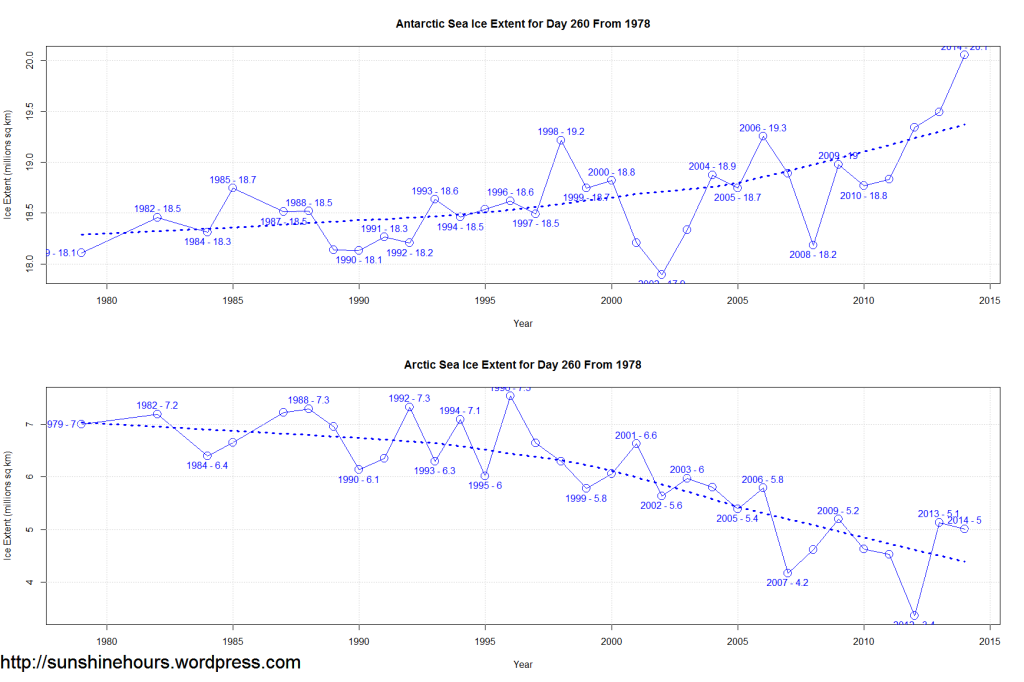





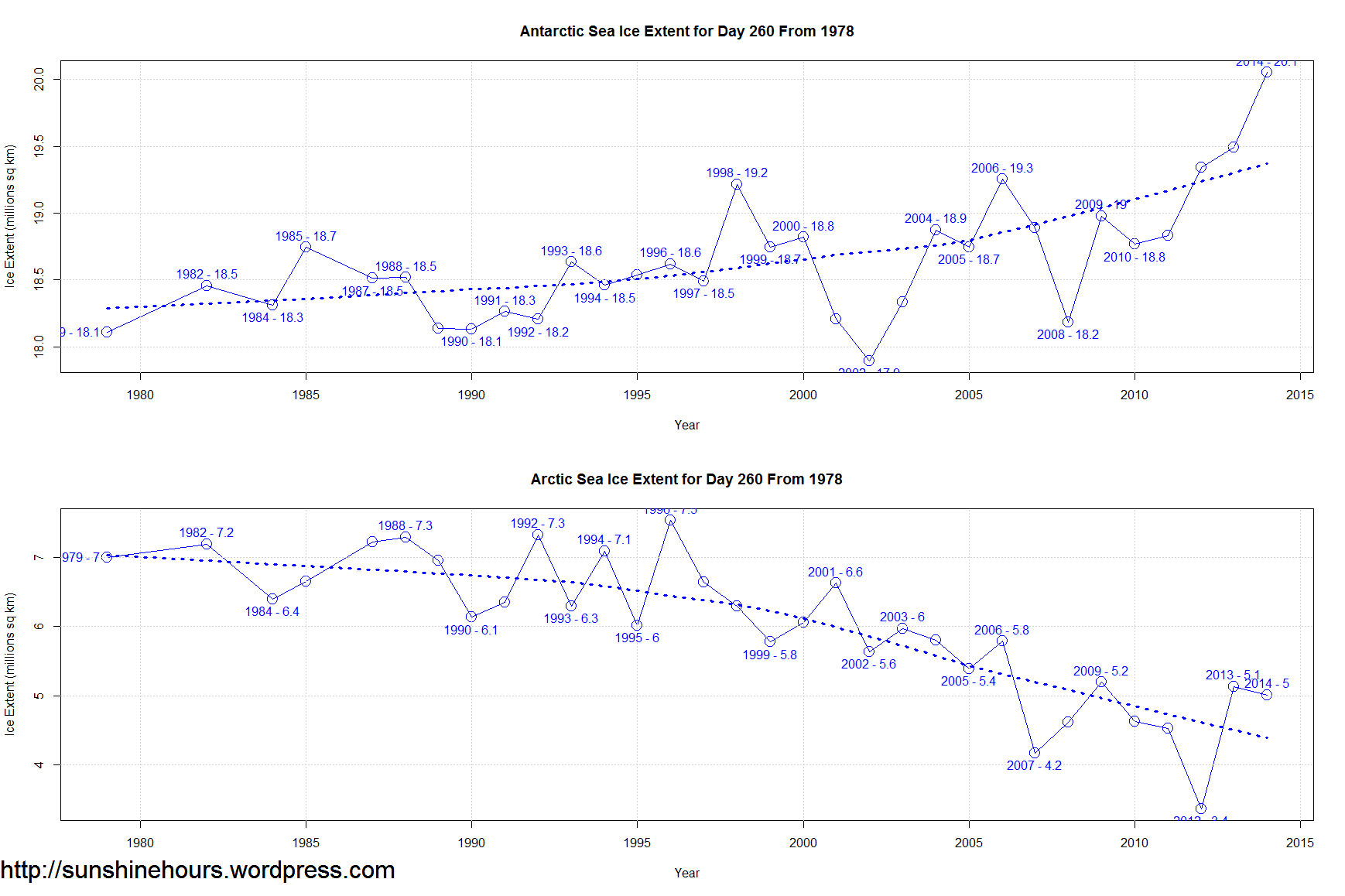
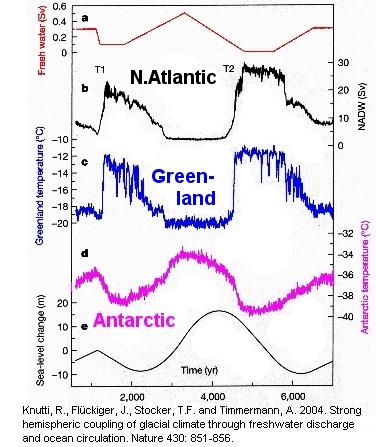
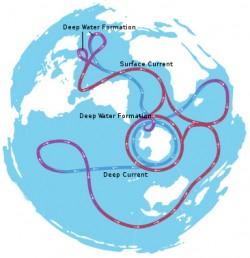
This new paper also discusses the seesaw theory and finds Antarctic changes precede Arctic changes by ~3,000 years
ReplyDeletehttp://www.clim-past.net/10/1751/2014/cp-10-1751-2014.pdf
Paper finds seesaw between N & S Hemispheres during last interglacial, and warmer during last interglacial
ReplyDeletehttp://www.sciencedirect.com/science/article/pii/S0277379114003382